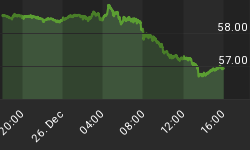The last week has been unique in many respects.
The S&P 500 closed out the week ending on December 2, 2011, with a 7.39% weekly gain, the 10th best week since 1950 and the 2nd best week ending in December since 1930 (best one ending on 12/10/1932).
In addition, the SPY (S&P 500 SPDR) posted it's fifth consecutive session (all within the same week) with a higher open, a higher low and a higher high (above the previous session's open | high | low), all up 0.25%+, and left two unfilled gaps up (low greater than the previous session's high) in just the last five days, in each case up 0.75%+ (the 2nd occurrence since 1990, first one on 10/15/2002). Even market breadth showed some uniqueness, with two 95%+ extremely lopsided volume days (95%+ of volume on the NYSE associated with advancing issues) during the week.
As already posted about several times during the last couple of days, we've entered into one of (if not THE) the strongest time frame(s) of the year, and even without accounting for the strong seasonality, the market regularly remained on firm path when those setups mentioned above had been triggered in the past.
Table I below shows all occurrences and the S&P 500 performance over the course of the then following three sessions in the event the S&P 500 closed out a week ending in December with a better than 3.50% weekly gain in the past. The short-term trend was regularly up (again), with twelve instances leading to a higher close two and three sessions later, closing higher 1.0%+ three days later on eight occurrences (or better than 50% of the time), and eight occurrences where the index never looked back and did not post at least one lower close one to three sessions later. Only one out of fifteen occurrences led to significantly lower prices (1.0%+) three days later.

Table II below shows all occurrences and the S&P 500 performance over the course of the then following three weeks in the event there had been two (or more) lopsided volume days (90%+ of volume on the NYSE associated with advancing issues) during the trailing week (rolling 5-day time frame). Although too a rare occurrence to be regarded as statistically significant, it is at least noteworthy that the index closed at a higher level three sessions later on all five occurrences, and only one led to fractionally lower prices two and three weeks later (on the final session of the respective week).

And last but not least: Table III below shows all occurrences and the SPY (S&P 500 SPDR) performance over the course of the then following two weeks (until the final session of the week) in the event the SPY posted five consecutive higher open | highs | lows (above the previous session's open | high | low respectively, and magnitude of change alt least +0.10% in order to avoid some noise around +/- 0%) in the past. Interestingly the SPY posted an immediate higher close on the then following session (in this event on Monday, December 5) on eleven out of twelve instances, and only two led to a 1.0% loss three sessions later and at the end of the week (in this event on Friday, December 9) as well.
But historically any pullback has provided a favorable buying opportunity: The SPY closed at a higher level at the end of the then following week (in this event on Friday, December 16) on nine out of twelve occurrences, and only three led to fractionally lower prices at the end of the period under review (max. loss -0.59% at the end of the then following week).

Conclusion(s)
The trend is up, and the markets may remain on firm path at least until the end of the year (seasonality, recent strength and unique price and breadth pattern).
Have a profitable week,
Disclosure: No position in the securities mentioned in this post at time of writing.
















